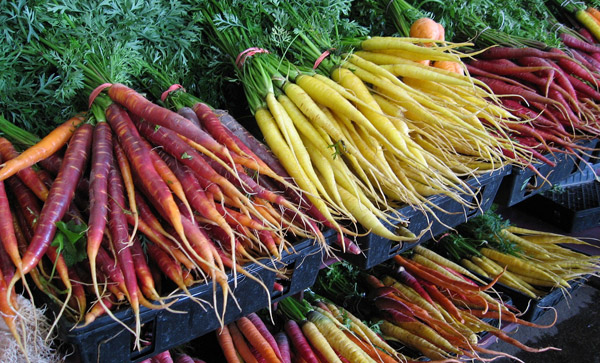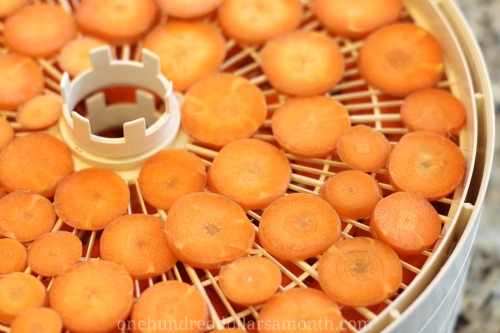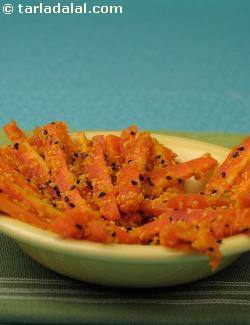CARROTS Today, I thought I would talk about storage of carrots.
While we usually associate carrots with the color orange, carrots can actually be found in a host of other colors including purple, yellow, red, or white. In fact, purple, yellow and red carrots were the only color varieties of carrots to be cultivated before the 16th century.
A 10-year study out of the Netherlands studying the carrot intake and risk of cardiovascular disease (CVD). Intake of fruits and vegetables in the study was categorized by color and focused on four color categories: green, orange/yellow, red/purple, and white. Out of these four categories, orange/yellow (and in particular, foods with deeper shades of orange and yellow) emerged as most protective against CVD. And carrots were determined to be the most prominent member of this dark orange/yellow food category. This new research knowledge, along with the long standing known value of carrots in regard to health makes keeping & putting up carrots, a most valued endeavor.
Nutrients in Carrots
1.00 cup (122.00 grams)
Nutrient% Daily Value
vitamin A407.6%
vitamin K20.1%
fiber13.6%
vitamin C12%
potassium11.1%
manganese8.5%
vitamin B68.5%
molybdenum8.1%
vitamin B36%
folate5.7%
vitamin B15.3%
phosphorus4.2%
vitamin B24.1%
vitamin E4%
Calories (50)2%
Even people who usually boil carrots have discovered that they taste better steamed! But whether you liked to have canned or boiled carrots, steamed or raw --- carrots are worth having in your food pantry & more so, your root cellar!
There are numerous ways to store carrots. The typical modern method is to buy them raw at the store; frozen or canned. However, they are not the only methods. Some alternative methods include storing in a root cellar as a dry root crop or in a root clamp; or dehydrating or freeze drying the carrots for long term storage.
METHOD #1: Root Clamp
This method would not work if you live in an extremely cold climate where ground freezes deeply, but in more mild climates, this method would be an effective way to store a large stockpile of carrots or other root crops.
METHOD #2: Canning
Canning has long been used by numerous cultures to store carrots. Some pickle the carrots, while others merely boil the carrots in a solution during the canning process in a pressure canner.
RECIPES:
Canned Carrots
How To Make Your Own Canned Carrots
Carrot Jelly
1 pound carrots 1 package
Sure Jell Fruit Pectin
1 package orange Kool-Aid
5 cups granulated sugar
Boil carrots until soft.
Remove carrots and measure 3 1/2 cups of the juice in pan to make jelly.
Boil juice for 1 minute.
Add remaining ingredients and boil 5 minutes.
Pour into jars and seal.
Process for 5 minutes in a boiling water bath. - See more at: http://www.recipegoldmine.com/canveg/carrot-jelly.html#sthash.uDy2DLiH.dpuf
Under-ground root cellar storage of carrots was the method my own mother & grandmother used for storage of our garden carrot crop. Each year we harvested the carrots. Removed the majority of the green top (leaving the rounded top in place with the green stub) and removed the soil from the tap root (carrot). Then we placed the carrots vertically in large crocks. Once the crock was full of carrots, we carefully poured in amongst the carrots fine sand until the sand filled the bucket well over the top of the carrots.
The crocks were ALWAYS filled in the place they were to sit for storage, due to the extreme heavy weight they became due to the sand, carrots & crock weight combined.
If you are using this method for the first time; Prepare the carrots like you're going to store them in the refrigerator. Then pack into containers surrounded by straw or moist sand or sawdust for keeping. If you don't own a large crock, you can use a large food safe tub or food safe bucket.
The Storage area should be approximately 32 degrees Fahrenheit, ideally and about 95% humidity.
METHOD #4: Sand Box
Sand boxes - If you have the space, say in a garage, try the sand box method - This method is basically the same as the one mentioned above, but doesn't depend on you having a root cellar.
METHOD #5: Dehydrating
Carrots are easy to dry. Simply top & tail the carrots & then wash & peel. Chop the carrots into slices and then place on the trays of your dehydrATOR, making sure the pieces aren't touching. Dehydrate for approximately 10 hours.
You can also choose to grate your carrots & create your own dehydrated carrot flakes. These should take between 6 & 10 hours to dry, and should be placed on Mesh Sheets. Carrots are 88% water so they will reduce in size considerably. When ready, the carrots should be crisp to the touch with no visible signs of moisture.
Dried carrots can be used directly in recipes where they will absorb a lot of water. Another great idea is to place the dried carrot pieces into a food processor and make into a fine powder which is delicious in soups, casseroles, drinks & more.To store your carrot pieces, flakes or powder, place in an airtight container in a cool, dry, dark place.
METHOD #5: Freezing
METHOD #5: Pickling
It is one of the easiest and most economical pickles to make. Use carrots, which are fresh, firm and without blemish. Wash them thoroughly and wipe them with a clean cloth before use. Traces of water will make the pickle rancid. With a beautiful bright red colour, this pickle goes very well will rotis or parathas. It is best eaten the day it is made. But it must be kept in the refrigerator to make it last for 4 days.
Storage (refrigerated for) : 4 days
Preparation Time: 10 mins
Cooking Time: 2 mins
Makes 4 servings
Ingredients
1 cup carrot , cut into thin slices
1/2 tsp nigella seeds (kalonji)
2 tsp split fenugreek seeds (methi na kuria)
2 tsp split mustard seeds (rai na kuria)
1/4 tsp asafoetida (hing)
1 tsp chili powder
1/4 tsp turmeric powder (haldi)
salt to taste
1 1/2 tbsp oil
Method
Combine all the ingredients, except the oil, in a bowl and mix well. Keep aside.
Heat the mustard oil in a small pan, add it to the carrot mixture and mix well.
Serve immediately or keep refrigerated till use.
Handy tips:
This pickle stays fresh for 3 to 4 days.
Indian or red carrots are ideal to use for this pickle.
Tips
Indian or red carrots are ideal to use for this pickle.
RECIPE SOURCE : Achaar Aur ParatheBuy this cookbook
OTHER RECIPES for Pickled Carrots:
Pickled Carrot Sticks
Easy Pickled Carrots
Vietnamese Pickled Carrots
Gajar Ka Achaar - Carrot Pickle
Spicy Pickled Carrots
METHOD #5: Refrigeration
Carrots can stay in the refrigerator, if stored properly for up to three months.


.JPG)








No comments:
Post a Comment